By Gulshan Chunara
MEVLANA’S MAUSOLEUM IN KONYA
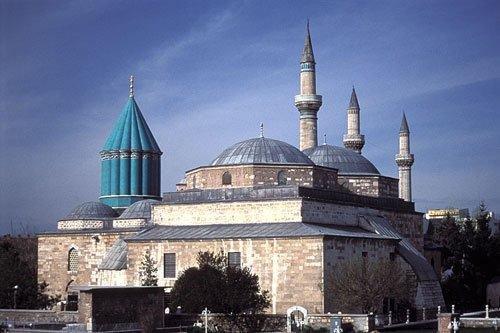
The shrine in Konya, Turkey, of the great Muslim mystic and saint Jalaledin Rumi. His tomb is situated directly under the green domed building. Photo: Gulshan Chunara.
Whoever you may be, Come
even though you may be
an infidel, a pagan, or a fire-worshipper, Come
our brotherhood is not one to despair
even though you have broken
your vows of repentance a hundred times, Come
I visited Rumi’s tomb in Konya in June 1989, my final destination after touring around Turkey for 7 days. My first impression of Konya was that it was more of a sleepy town, with many little shops selling the famous green Konya pottery, religious icons and tasbhis. I noticed that women covered their head with hijab, compared with the modern city of Istanbul where they mostly wore Western clothes. It must have seemed to some Western eyes that Konya was caught up in a time-warp, but here was a good example of people retaining their traditions of a modest dress.
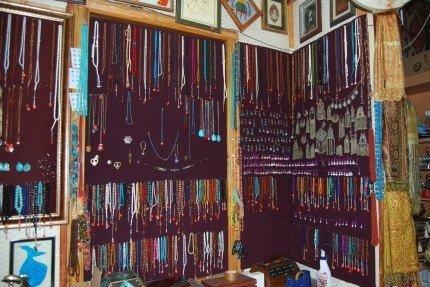
A shop in the town of Konya, where Rumi lies buried, selling religious icons and tasbihs. Photo: Gulshan Chunara.
Mevlana (teacher) as Rumi is often referred was a great 13th century mystic Sufi poet. He was at first an academic and a great scholar like his father, until his chance meeting with Shams-ud-din of Tabriz, an Ismaili, in a local bazaar that transformed Rumi into a great mystic poet, artist, musician and a performer (a bohemian in modern terms). Rumi was born in Balkh in Persia (present day Afghanistan), but emigrated at a tender age of 12 to Konya, situated in central Anatolia (present day Turkey) with his father, as the Mongols invaded his motherland.

Main entrance to Rumi’s tomb. Photo: Gulshan Chunara
One has to enter the main entrance to see the tomb of Rumi, which is situated directly under the green minaret of the shrine, covered with a massive handmade Konyan kelim and a green turban placed on the top, as well as containing other tombs belonging to his descendants. Looking at his tomb one can say that it is something that one does not come to simply admire.
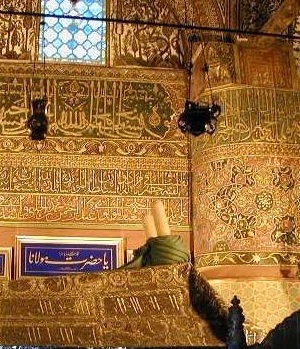
A section of Rumi’s tomb. Photo: Gulshan Chunara
In fact, the tomb is regarded as a sacred sanctuary where Qur’anic verses such as the Fatiha (the opening) and Surah Yaseen are recited. The latter Surah details resurrection and judgment in a most emphatic way, and traditions say that Prophet Muhammad (s.a.s) referred to the Surah as the heart of the Holy Qur’an.
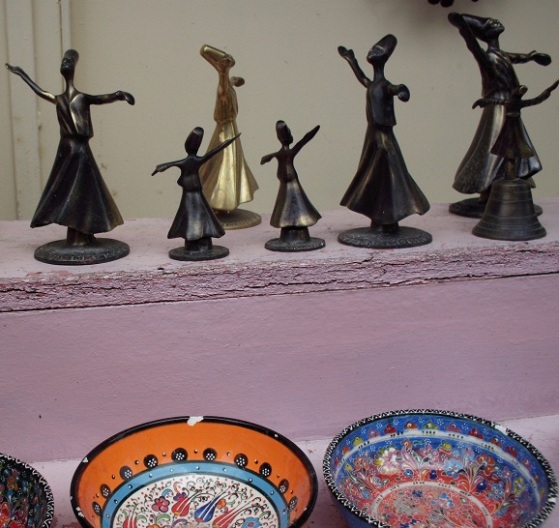
Sculptures of Whirling Dervishes in a gift store in Turkey. Photo: Navyn Naran.
Another room beyond his tomb was once used by the whirling dervishes, who are said to go into a religious ecstacy by the ritual of performing the twirling dance, said to have been introduced by Rumi’s Mevlevi order. The whole ceremony associated with the twirling dance is known as the Sema ceremony, and it is interesting to note that in 2005 UNESCO proclaimed the The Mevlevi Sema Ceremony of Turkey as amongst “the Masterpieces of the Oral and Intangible Heritage of Humanity”. This room is now a small museum exhibiting his Divan, the Mathnawi, handwritten copies of the Holy Qur’an, his garbs, tasbhis and instruments such as the Ney, an end-blown flute.
A memory to be cherished.
_________________
TEKKE ON THE SPRING OF BUNA IN BLAGAJ
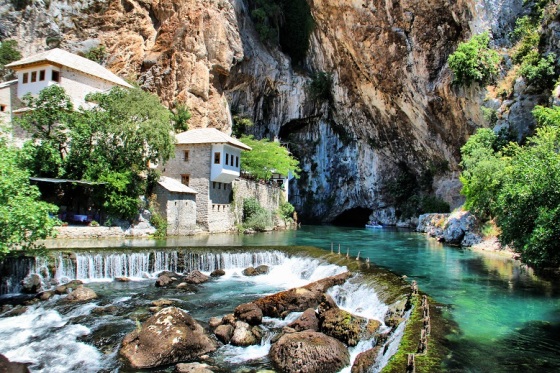
The historical Blagaj Tekke (Dervish monastery), built on the side of the Green cave on River Buna. Photo: Wikipedia
Blagaj is an oasis of natural beauty and it is 3km from Mostar. As soon as you arrive you feel the cool and fresh touch of the transparent Buna river. The magnificent Green cave above it dates back to 6500BC. The fragrance from the Tekke garden enters your body and soul as you stroll along and it was and is believed to be the place of meditation for dervishes and people alike.
The Tekke, a dervish monastery built on the Buna spring in Blagaj was founded by the dervishes of the bektashi order in the 16th century. A famous traveller of that time, Evlia Chelebi wrote that the mufti of Mostar, Ziaudin Ahmed-ibn Mustapha, had the tekke of the helveti order built as a place where the ”dervishes would meet for their friendly talks and debates”. In the middle of the 19th century, when it belonged to the dervishes of the kadarite order, it was renewed by Omer Pasha Latas. Today, the tekke is in possession of the dervishes of nakshibendi order.
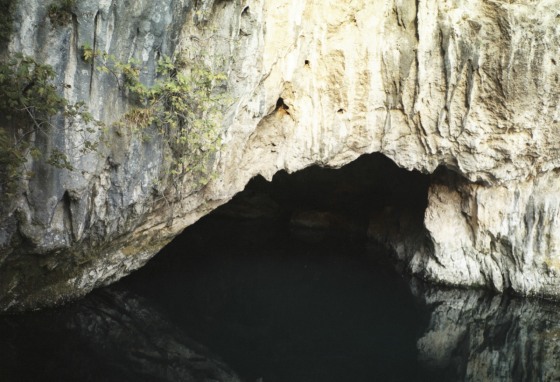
A close-up of the cave. Photo: Gulshan Chunara
The meeting/prayer room of the tekke has the characteristics of the Turkish baroque and is the only monument in Bosnia built in that style, and this can be seen on the wooden ceiling.
The hamam, a turkish bath, is especially interesting, because it had the heating under the floor and it is covered with a beautiful starry holed dome for the natural light to enter through it.
The Turbeh, a mausoleum built next door to the tekke, is worth seeing, because there are relics of Sari Saltuk and Achik Basha, both lslamic missionaries of Turkmenian origin who lived and practiced Sufism at in the mid 13th century.
There are many legends about Sari Saltuk, of which one is that in one of his many wills he ordered eight coffins to be made after his death and sent to eight countries, but only one of them would contain his body, so that the pilgrims would travel and look for his real tomb and at the same time spread Islam. However, it is believed that the tomb in Blagaj contains his remains.
____________________
SHAKESPEARE AND COMPANY
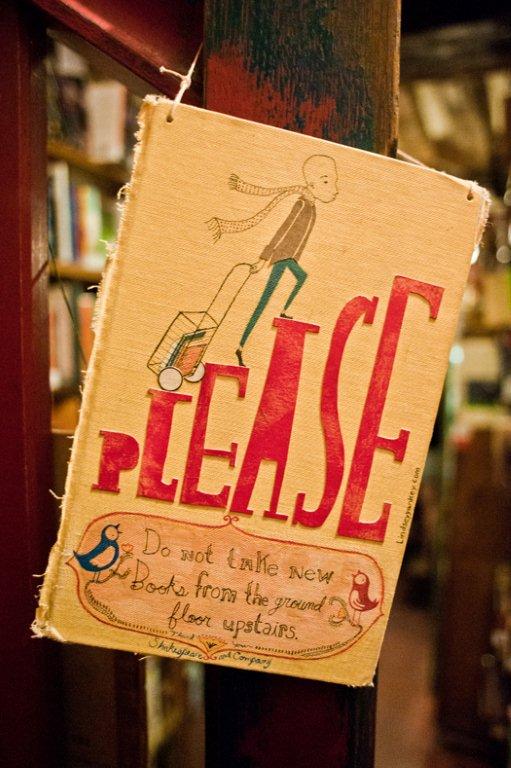
Inside Shakespeare and Company. Photo: Gulshan Chunara
From two places of immense religious interest, I turn my attention to an iconic bookstore in Paris. I first discovered Shakespeare and Company by accident as I was walking down towards Notre Dame one afternoon after leaving the language centre in October 1980, when I went to Paris to do an intensive twelve week French language course at Sorbonne Nouvelle, an annexe of Sorbonne University, that caters to foreign students wanting to learn French. I stayed in a rather shabby-run-down-chique hotel that had not had a facelift for at least 80 years and was only five minutes away from the language centre on Avenue des Gobelins, which any French person will tell you was an area famous for Gobelins tapestry. The bookstore became a regular haunt of mine during my stay, spending at least half an hour browsing and skimming through musty smelling second-hand books.
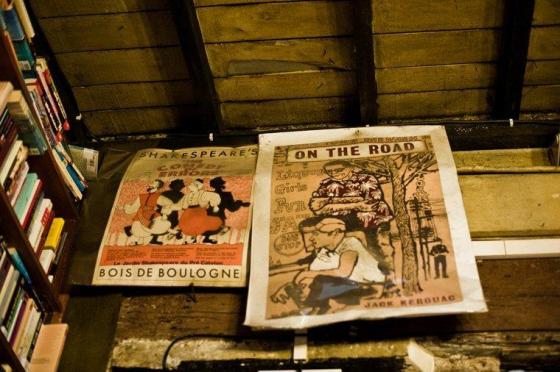
Inside Shakespeare and Company
Shakespeare and Company was and still is an independent bookstore situated in the Latin Quarter simply known as the Left Bank, and a stone’s throw away from Sorbonne University, which for centuries has been the centre for Parisian writers, professors, artists, and the lefty intellectuals. Originally established in 1919 by Sylvia Beach, an American living in the 1920s Paris, the bookstore was a gathering place for writers such as Ezra Pound, Ernest Hemingway, William S. Burroughs, James Joyce and Ford Madox Ford.
Today, Shakespeare and Company serves as a bookstore specializing in English-language literature, and also has a boarding house for aspiring writers and a reading library. The current store is named after and in honour, of the earlier store which closed during the Second World War, never to be re-opened.
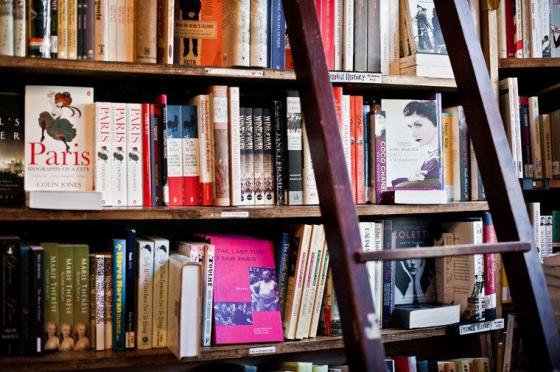
New book section. Photo: Gulshan Chunara
In 1951, in a post-war Paris, George Whitman opened another English-language bookstore under the name of Le Mistral. Much like the original Shakespeare and Company, the bookstore served as a focal point for literary culture in Bohemian, Left Bank Paris. Whitman later changed his bookstore’s name to Shakespeare and Company, in honour of Sylvia Beach after her death.
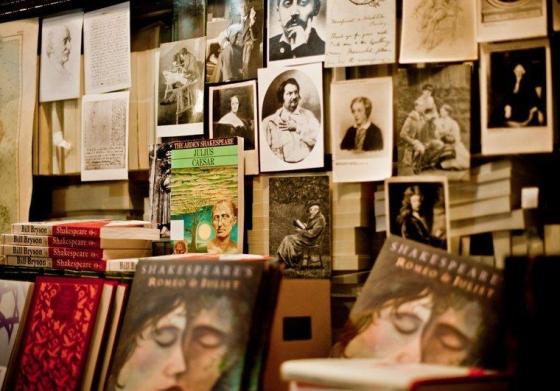
Books, photos and letters. Photo: Gulshan Chunara
Whitman called his bookstore “a socialist utopia masquerading as a bookstore”. Since 1951, the bookstore has stubbornly kept its utopian ideals in a changing world. Many who knew the store back in their youth return as adults to find an institution that has not been altered by the passing years. Whitman passed away in 2011 at a ripe old age of 98, in his flat above the bookstore. Sylvia, his daughter, named after Sylvia Beach, now runs the shop. The store continues to operate at 37 rue de la Bûcherie, near Place St. Michel and is steps away from river Seine and Notre Dame on Île de la Cité.
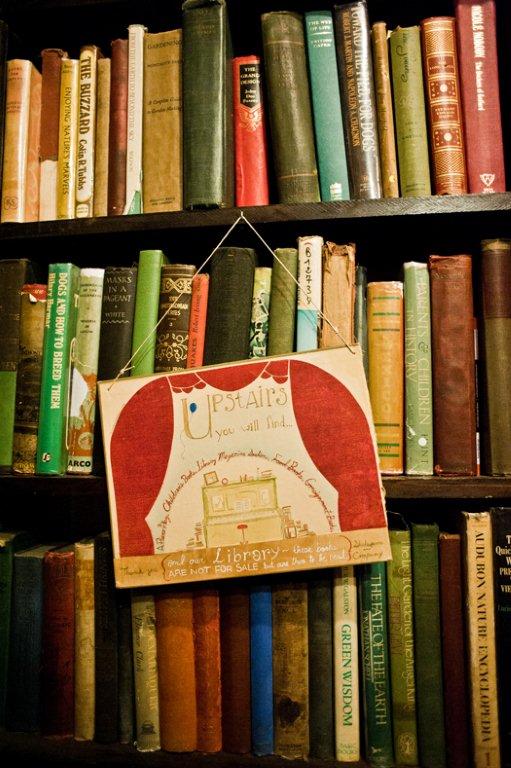
A sign in the bookshop. Photo: Gulshan Chunara
The bookstands in front of the store’s facade is surrounded by an ornate drinking fountain, erected in the 19th century to service the area’s poor. Inside, there’s an extensive stock of second-hand books. Weekly gathering goes on in the bookstore every Sunday teatime, serving tea and scones with poetry readings and writers’ meetings. Anyone planning a trip to Paris must spare a couple of hours to visit this fascinating time-warped store.
Date posted: Saturday, September 22, 2012.
Copyright: Gulshan Chunara.
________________
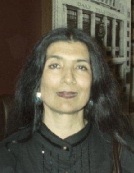
Gulshan Chunara has travelled widely
About the writer: Gulshan Chunara has spent all her life in London, England. She worked for the Daily Telegraph for 30 years as an editorial assistant to specialist journalists in the newsroom. She is now working as a casual with Express Newspapers Group, which also includes Hello magazine.
______________
We welcome feedback/letters from our readers. Please use the LEAVE A REPLY box which appears below. Your feedback may be edited for length and brevity, and is subject to moderation. We are unable to acknowledge unpublished letters. Share this article with others via the share option below. Please visit the Simerg Home page for links to articles posted most recently. For links to articles posted on this Web site since its launch in March 2009, please click What’s New. Sign-up for blog subscription at top right of this page.

Lucky lady! My wish was just to do that later this year, but the political situation in Turkey seems a little stormy, pray, it soon settles.
Thank you for enlightening us.
A very good piece. Thank you for enlightening us.
Greetings from Thailand, Gulshan,
Your photo essay of three very unique and iconic places of our wonderful planet were a great to joy to read and has made me want to get to all of them in person one of these days…What a great way to blend eccentric people and places into one essay. Well done!
Mo Tejani
(Simerg author)
Gulshan Chunaara, Ya Ali Madad
This is a very good piece and I really liked it.
Anwar Allahwala
Greetings Gulshan,
Great pictures and beautifully described. Brought back lots of memories of sleepy Konya, Unfortunately Konya is now a hotbed of radicals of all stripes.
Merci
Muslim